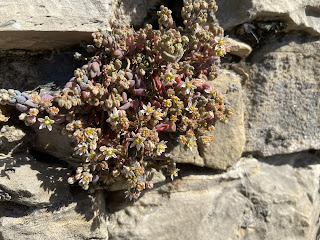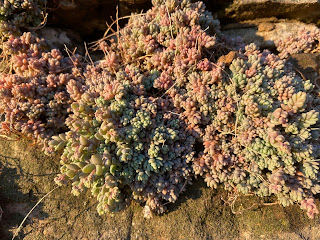


Left: Photo of Sedum dasyphyllum on a wall in Bergamo.
Center: Photo of Sedum dasyphyllum and Sedum album in bloom on a wall in Bergamo.
Right: Nestled in a wall, Madonna della borraccina, the protector of sedum.
Both of these Bergamo Wall Plants ™ plants are part of the genus Sedum, commonly referred to as stonecrop. Stonecrops are in the family Crassulaceae, also known as the stonecrop or orpine family.
Sedum album – White Stonecrop – has alternate, fleshy leaves that are nearly cylindrical with rounded tips. The Italian name for S. album is borraccina bianca. Its flowers are in a corymb structure.
Sedum dasyphyllum - Thick-leaved Stonecrop or Corsican Stonecrop – has opposite gray-green leaves, often tinged pink. This stonecrop's leaves are more plump-looking compared to S. album. The Italian common name for S. dasyphllum is borracina cenerina. Both of these sedums found in hot, dry locations on walls with good sun exposure. Often they are growing next to each other as shown in some of the photos here.
The etymology for these plants as follows. Sedum is from the Latin sedum meaning "houseleek" as least as far as Wikitionary is concerned. Sempervivum tectorum – Common Houseleek – is also in the Crassulaceae family. Another possible etymology we found interesting because of its reflection on the Italian language is given in the Italian Wikipedia page for Sedum album. The entry claims that sedum comes from the the Latin verb to sit, sedeo, "I sit". In Italian it's io mi siedo. The connection is the way the stems lay down or sit. (Sedere – to sit – is one of the verbs in Italian that throws an I in during conjugations: siedo, siedi, siede, sediamo, sedete, siedono.) Who knows for sure what the exact etymology is, but we won't forget the conjugation of this verb.
Continuing: Album is "white". Dasyphyllum – according to dryades.it – comes from the Greek dasýs meaning "hairy" e phýllon meaning leaf. If you look closely, sure enough there are hairs.
A list of our wall plants of Bergamo thus far:
- [Papavero] Fumaria officinalis (post) – Earth Smoke
- [Brassicaceae] Aubrieta deltoidea - Purple Rock Cress and Iberis sempervirens - Evergreen Candytuft (post)
- [Geraniaceae] Geranium robertianum (post) - Stinking Bob
- [Asteraceae] Erigeron karvinskianus (post) - Mexican Fleabane
- [Aspleniaceae] Asplenium ceterach (post) - Rustyback Fern
- [Aspleniaceae] Asplenium ruta-muraria (post) - Wall Rue
- [Aspleniaceae] Asplenium trichomanes (post) - Maidenhair spleenwort
- [Urticaceae] Parietaria diffusa (post) – Pellitory
- [Plantaginaceae] Cymbalaria muralis (post) - Pennywort



Center and right: Sedum album on a wall.



Right: Sedum daspyphyllum in spring with flowers.




No comments:
Post a Comment
All comments are moderated. If your comment doesn't appear right away, it was likely accepted. Check back in a day if you asked a question.